Text and photos: Text: Akul Tripathi, Photos: India City Walks & Rangan Datta
Iwish I could paint…draw, even if only in monochrome, outline the world around me and the several others I have had the good fortune of visiting. With illustrations would come pictures of places. Yes, yes; there are photos, I know, but my sketches would not just be representations of how these places are to an impersonal, robotic, optical eye. They would be how my eye sees them. Not just light reflected through lenses but light filtered through memories and understanding and then mixed with all the other senses, culminating in a visual that is more than just colourful dust and metal.
But, alas! The fates in their incomprehensible wisdom have restricted my sketching skills to mere characters – only 26 inscription strong – which permit only so many variations of which I know so few; rendering me ill-equipped to describe or depict the grand adventure of being alive in this world.
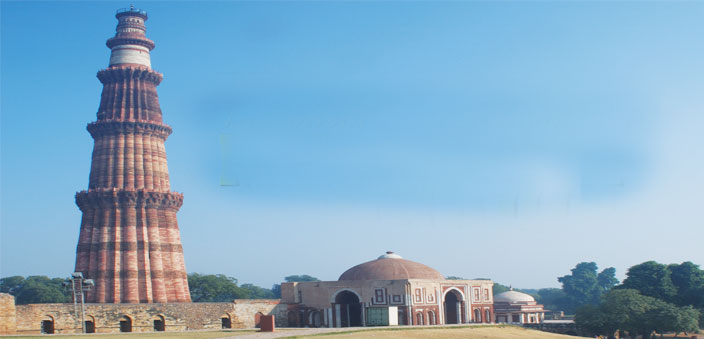
It is with this forewarning, that everything you are to read does only a fraction of justice to the experience of being there and treading these paths, that I shall take you on a walk within what we today call as Delhi – a geographic region that has come to represent the capital of India for over a millennium.
The many Delhis
Plurality is encountered in Delhi as frequently as one does VIP cars. Its name is itself a testament to the pluralities that thrive here. Its many meanings speaking of its many histories and in that one word encompassing the many immortal avatars that coexist simultaneously, often overlapping in a coalescing symbiosis, rendering them indistinguishable at the seams; moulded together as one continuous entity.
Its oldest ancestry derives from records so ancient that it is difficult to distinguish fact from fiction. The first city to have been founded in the region of Delhi is equated by those with the belief, to be the Pandava capital of Indraprastha. As per legend, the Pandavas burnt and cleared the Khandavaprastha forest and established a city there. This city was modelled on the heavenly city of Lord Indra and is said to have surpassed even that in beauty and grandeur. Despite excavations in the area considered to be where Indraprastha would have been most likely built, no archaeological evidence of an Indraprastha were unearthed, relegating the Pandavas and its capital to realms of fantasy.
The oldest inhabitation archaeologists have uncovered are from the Lower Palaeolithic era or the old stone age, which are conservatively estimated to be 200,000 years old, could be as much as 3.3 million years old! Whatever be its ancient origins, human civilisation in the area is universally accepted to have existed by the 6th century BC. Since then, it is acknowledged through archaeological remnants that at least seven major cities existed in and around the region of Delhi with the present capital of New Delhi, being the eighth Delhi in human memory. Yet, whence the name Delhi or its phonetic similes came in being and how, is a matter of greatly disputed yet riveting debate.
As per one school of thought, Yudhisthira of the Mahabharata was succeeded by 30 generations of his brother Arjun’s descendants before the last of the line was overthrown by his minister – Visarwa. Visarwa was ousted by the Gotamvanas dynasty who were subdued by the Mauryas in the first century BC. A common view is that the name originated from Raja Dhilu or Dilu of the Mauryan dynasty, who reigned in the first century BC and founded a city in these environs and the various names by which the city has been known – Dhilika, Delhi, Dilli, Dillipur and Dhilli have been corruptions of the king’s names. Ashokan edicts found in the area lend weight to this hypothesis.
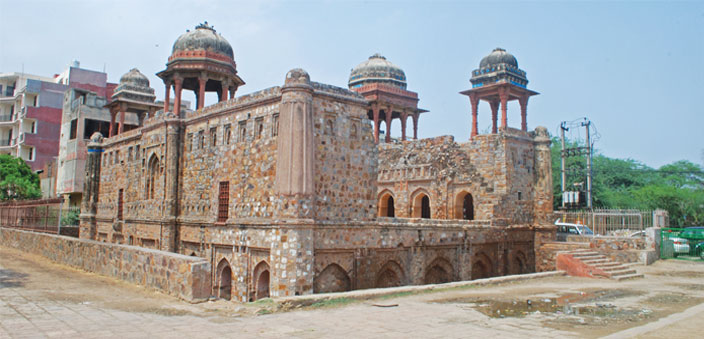
The history of Delhi, however, may be said to begin with Anang Pal who founded the Tomar dynasty in the eighth century CE. It is said that in his reign, a learned brahmin disclosed that the foot of the pillar was driven deep into the earth, such that it rested on the head of the serpent Vasuki, the king of serpents who holds the world on his hood. To verify this, legend says that the king had the pillar dug up on and on finding blood, tried to refix it but it remained loose or dhila and from this comes the name Dhili.
It was the Tomars who built the first of the seven medieval cities of Delhi when Anang Pal II built the Lal Kot – the first fort of Delhi; presently situated between Sanjay Van and Mehrauli. Another school of thought believes that it was Anang Pal II who brought the iron pillar from Udaygiri in Madhya Pradesh and affixed it outside his fort and since it was not fixed properly, it began being called Dheeli Killi – (loose nail). Another Rajput clan – the Chauhans defeated the Tomars in the 12th century CE and Prithviraj Chauhan (1149-1192) popularly known as Rai Pithora, extended the old city of Lal Kot. This extended city came to be known as Qila Rai Pithora.
From Qila Rai Pithora, Delhi became a Sulanate of the Mamluks and the Siri of Allaudin Khilji. The first Tughlaq – Ghiyasuddin made it Tughlakabad, and his son Mohammad bin Tughlaq walled in the suburbs between Siri and Qila Rai Pithora creating Jahapanah. Firoz Shah Tughlaq then built Firozabad. The city around Purana Qila housing Dinpanah built by Humayun, and Shergarh of Sher Shah Suri. The Muhgals added their own touch with Shah Jehan founding Shahjahanabad – the current Old Delhi. The British made it the capital of the Indian Empire in 1911 and Edwin Lutyens designed a capital for the empire – New Delhi.
Though this cannot be said officially, since whatever be the reason, Delhi was destroyed so often, it could have been called Dahal Uthi or Dahali; meaning ‘shook up’. Or it can be as simple as having derived from Dehleez or Dehali – ‘threshold’ – and symbolic as the city that is the gateway to the Indo-Gangetic Plain.
While today, Indraprastha is banished into the twilight of fan fiction and confined to a vague closet of mythology, the other cities of Delhi poke out from its earth obstinately, driven perhaps by the fear of being locked in the same closet. Amongst all of these, there is one plot of Delhi’s earth that holds within its loosely defined boundaries a piece of every Delhi from known antiquity – Meherauli.
The many Mehraulis
Mehrauli village is probably the oldest continuously inhabited area of Delhi, evolving over several centuries. In a continuing vein of plurality of opinion and views, Mehrauli too holds its own with several attributes attempting to justify its name. While one holds its name as having derived from a settlement of Mihirawali – Home of Mihir, founded by King Mihir Bhoja, probably contemporary to the Tomars. Another belief points to the Qutub Minar – the most famous resident of Mehrauli – being an astronomical observatory to the famous astronomer Varahmihir from where the area gets its name. Still another legend is that the name is derived from the Mehrawali Mai (Mehr = blessings), whose temple is close to Adam Khan’s tomb. Yet another interpretation credits the name to be a corruption of ‘mehr-e-wali’ (wali = custodian, helper) indicating perhaps the residence of a holy man who conferred blessings.
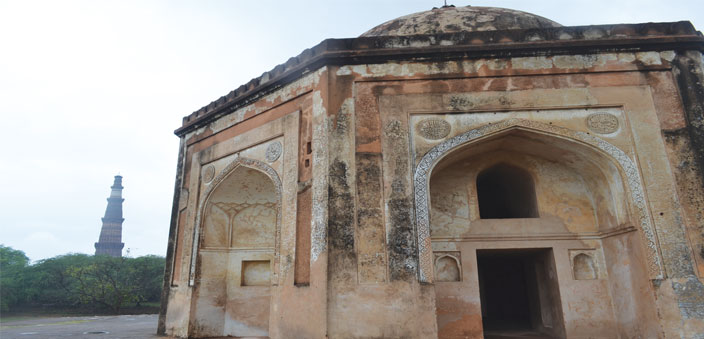
Mehrauli, as a current geographical entity lies in the south-western district of Delhi and represents a constituency in the legislative assembly. Within its thinly guised veil of a suburb of a modern day capital city, is a sprinkling of monuments which appear to be placed randomly, but are in fact the setting of a game as simple and ingenious as join-the-dots, and when correctly looked at, build a road map of Delhi’s history.
Temples, mosques, tombs, step-wells, palaces and forts form the dots that serve as time warps. Along with the Yogmaya temple, Meherawali Mai temple, Adam Khans tomb are tombs of Qutubuddin Bakhtiyar Kaki, Mughal Emperor Shah Alam II and his son Akbar II. The Bagichi Ki Masjid, Madhi Masjid, bastion of Lal Kot, Gandhak ki baoli, Zafar Mahal, Jahaz Mahal and innumerable such relics of time remain the landmarks that serve as local GPS and as sieves of an incredibly plural identity.
Within the larger puzzle of Mehrauli is another smaller puzzle which forms on joining its dots, the picture of an earnest custodian of the past. And like with all earnest custodians, their labour of love often lies in the shadow of more flamboyant neighbours. So while Mehrauli is a name one immediately associates with the environs of Delhi and the Qutub Minar, it is within the radius of that great shaft that lies – eloquent in its earnestness, a sanctum sanctorum of Delhi’s heritage – a microcosm of its history – the Mehrauli Archaeological Park.
The many within Mehrauli Archaeology Park
The Mehrauli Archaeological Park (MAP) is the name given by the Archaeological Survey of India to the area near the Qutub Complex in Mehrauli which contains over a hundred historically significant monuments representing each era of Delhi’s history. It is a woody area spread over a couple of hundred acres abutting the World Heritage Site of the Qutub Complex, and in relative seclusion allows the present to walk in freely and mingle with the past, letting yet another level build on its multi-layered offering.
On first thought, the MAP would strike a picture of many monuments huddled together like peas in a pod, it is only once inside that one can gather just how big 200 acres can be! While one can drive through some parts, especially the arterial path that runs the length of the site, the park is best explored on foot; and though it seems that one can explore by oneself, it is easy to get lost as well as miss out on many interesting and significant details. The best way is to have someone who knows the lay of the land, to walk along. In my case, I chose the good people at India City Walks, who guided me through the wormholes of time travel in the park. While the highly recommended walk in the park is designed by them to keep visitors’ legs happy over chronology, this narrative would be better understood through a linear ride down time.
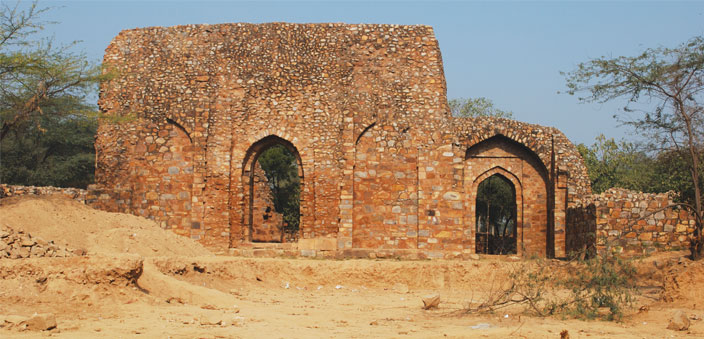
The Rajput era
The oldest surviving city of Delhi – the Lal Kot of Anang Pal II is known mainly by its fortifications which have stood for over a millennia. Expanded further into Qila Rai Pithora, the original city has faded into traces of forgotten memories, sections of its once snaking walls crop up in the most unlikely of places. One such section of the wall stands guard within the premises of the MAP, hidden away from sight in the foliage just as it stays elusive from memories of those who live in the vicinity.
The Delhi Sultanate era
The area of Mehrauli came into its own during the rule of the Delhi Sultanate – five unrelated dynasties that ruled from Delhi till 1526. This was especially true in the era of the first of these – the Mamluks. The word Mamluk literally means ‘owned’, and finds its roots in the slave trade industry. Children would often be sold into slavery and a soldier of slave origin who had converted to Islam would be called Mamluk. The first king of the Mamluk dynasty was Qutb ud-din Aibak, whose name garlands the Qutub Complex.
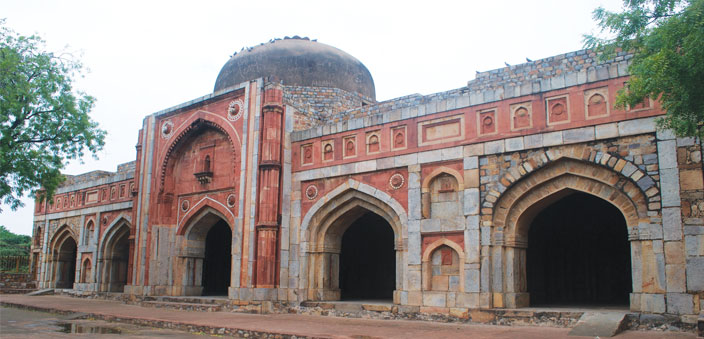
After finding himself spared by Prithviraj Chauhan, Muhammad Ghori returned and defeated the Rajputs in the second Battle of Tarain. After conquering the Qila Rai Pithora, Ghori left again for Khorasan in Persia, leaving the provinces in the Northwest India under Qutb – his slave general – for consolidation. It is said that Muhammad Ghori treated his slaves like sons and trained them in military practices and in administration. In 1206, Ghori was assassinated and being issueless, it was almost willed that his slaves would take over his many dominions. In such manner, the north-west Indian part of Ghori’s kingdom fell to his slave Qutb who soon received manumission and proclaimed himself emperor. Qutb ruled from Lahore, where he died due to injuries sustained in a polo accident.
After Qutb, Aram Shah – whose relationship with Qutb is unclear – assumed rulership in Lahore. However, the powerful nobles invited his son-in-law Iltutmish to take charge at Delhi. Iltutmish ascended the throne at Delhi and defeated Aram Shah in battle, making himself Sultan. While Qutb ud-din Aibak was the first to use the title of Sultan, the Slave Dynasty is believed by many to begin from him as he received the Caliph’s investiture and consolidated power in the region for the Mamluks. The tomb of Iltutmish, which is the first Muslim mausoleum built in India, is also in Mehrauli.
The Mamluks were in a lull after the death of Iltutmish and it was after five short reigns that Ghiyas-ud-din Balban ascended the throne. A slave bought by Iltutmish, he had advanced swiftly in his career and at the age of sixty, he proclaimed himself Sultan. He ruled with an iron fist and was so effective that he is spoken of in the same breath as Iltutmish. He construed a theory of kingship to suit his ends, and titled himself as zil-i-ilahi or shadow of God.
He maintained a magnificent court to impress and awe the people who called on him. In public and private, he maintained a sober, even temperament so that he was never seen in a non-serious mood. He even gave up drinking for the same reason. He also insisted on the ceremony of sijada (prostration) and paibos (kissing of the monarch’s feet) in the court. The legacy he left behind after twenty years of rule was of greater power in the monarchy, which would set the customs and practices for many years to come.
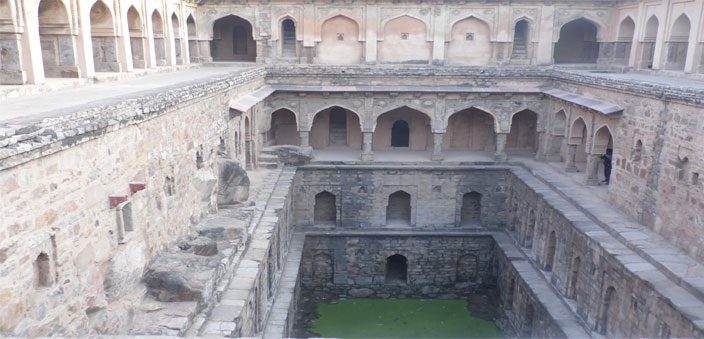
The Tomb of Balban is situated within the MAP. It’s a square building with spacious rooms on either side. It is approached through an entrance gateway with column and beam structure, which is commonly seen in pre-Turkish Indian architecture. Architecturally it is seen as an important structure, as it represents the first in the amalgamation of features of Indo-Islamic architecture. It is almost unanimously accepted as the first major monument where a true arch and a true dome were built for the first time in India. The dome however hasn’t survived and it is only within walls of true arches that Balban today lies buried. The stone sarcophagus that must have once stood over the grave has also disappeared. The royal tomb today lies forlorn, surrounded by the ruins of an urbanised late medieval settlement.
It is believed that the building was not designed as a royal tomb, but was in fact a monument called Dar-ul-Amaan or House of Refuge built in 1280 AD. Ibn Batuta describes it thus:
‘One of his acts of generosity was this: he built a house to which he gave the name, “Abode of Security”. All debtors who entered it had their debts discharged, and whoever in fear fled there for refuge found safety. If a man who had killed another took refuge there, the Sultan bought off the friends of the deceased; and if any delinquent fled there he satisfied those who pursued him. The Sultan was buried in this building and I have visited his tomb.’
In a room adjoining the burial chamber of Balban, lies a large cenotaph covered with red sandstone. It is believed that this is the grave of Balban’s eldest and favourite son, Muhammad who died fighting the invading Mongols. After death, he was praised as a martyr and given the title of ‘Khan Shahid’. Folk memory remembers Khan Shahid as a very pious prince. Balban however, is remembered as a very cruel man whose way to the throne was fraught with violence and bloodletting. Many see this as a reason why Balban is cursed with an afterlife under the sky with no stone to mark his grave. While the grave of his son Khan Shahid is visited by many and worshipped by leaving offerings of incense, money, fragrant oils, sweets and marigold flowers
Muiz-ud-din Qaiqabad, the grandson of Balban was the next and last Mamluk Sultan and he moved the capital from Mehrauli to Kilkori on the banks of the Yamuna. Even though the slave dynasty ended in 1290 with the murder of Qaiqabad, the other dynasties contributed significantly to the architecture of Mehrauli. Qaiqabad was murdered by Firuz-ud-din Khilji who came from the line of Bakhtiyar Khilji and were vassals since the time of Qutb-ud-din Aibak up to Balban. Ala-ud-din Khilji, the second Khilji ruler built monuments in the Qutub complex and Firoz Shah of the ensuing Tughlaq dynasty writes in the Futuhat-i-Firozshahi that the four arches of the entrance are all that remain of the tomb. Firoz Shah carried out extensive repairs in the area and especially at Balban’s tomb where he writes he had sandalwood doors and curtains installed.
The Sayyid dynasty followed that of the Tughlaqs. Khizr Khan was the governor of Multan under Firoz Shah Tughlaq and when Timur attacked Delhi, he sided with the Mongols against the Tughlaqs. Timur sacked Delhi in 1398. Claiming descent from the Prophet Muhammad through his daughter Fatima and son-in-law Ali, the Sayyid ruled for a short period from 1414 to 1451 when Alam Shah abdicated the throne to Bahlul Lodi.
Bahlul Lodi began the last dynasty of the Delhi Sultanates – the Lodi dynasty. The family of Lodi had served under the Tughlaqs and then the Sayyids. Bahlul Lodi had a long reign and was a vigorous leader. His son ruled as Sikander Lodi after his death, followed by his youngest son Ibrahim Lodi, and it is in his reign that a major monument was built in the area of the MAP – the Rajon ki Baoli.
Rajon ki Baoli, as the name suggests, is a four level step-well with steps at one end and a circular well at the other. There are long covered corridors along the length of the step well and rooms behind the arcade that would undoubtedly have given shade and shelter to visitors. It is quite an elaborate affair with decorative features and an attached mosque and tomb. While the name suggests it was built with by masons (Rajon) or for masons, an inscription on the tomb tells us that it was built by Daulat Khan during the reign of Sikandar Lodi in 1506, over the remains of one Khwaja Mohammad. The tomb is in the form of a chhatri or pillared kiosk. Daulat Khan himself is buried in the tomb.
However, in the late 19th or early 20th century, a group of masons started living in it as places like this afforded good shelter. They were eventually evacuated by the Archaeological Survey of India in the 1920s, their short stint is perhaps responsible for this nomenclature. Just as remarkable as the oddity in the nomenclature is the very digging of the well in an area like Mehrauli which is within the Delhi Ridge of the Aravali mountains, and digging through sheer rock to get at water is definitely a commendable effort. If only more could be done to honour it with clean water.
The Mughal era
The reign of the headstrong Ibrahim Lodi was one filled with rebellions from various parts of his empire. In addition was the threat of the Mughal Babur harassing his north-western borders. Finally, in the First Battle of Panipat, Babur defeated Ibrahim Lodi and won Delhi from him. The Mughals would go on to form an empire that would rule for almost three and a half centuries. While the world was changing without, it couldn’t have done so without leaving a mark in the MAP – the mosque and tomb of Jamali-Kamali.
Jamali (meaning good looking) was the nom-de-plume of Hamid bin Fazlullah – a merchant turned Sufi who lived through the end of the Lodi and beginning of the Mughal period. Jamali was a well travelled poet and favourite of four successive rulers of Delhi. From Sikander Lodi to Babur’s son Humayun, he found favour at all courts. He accompanied Humayun during the conquest of Gujarat, and died there in 1535.
As was common practice in the medieval era, the place where the saints lived would become their tombs. The chamber in which Jamali lived was converted into a tomb and he was interred there in 1536. The tomb, however, was built in the period between 1528 and 1529. While very plain looking from the outside, stepping into the tomb is like entering a veritable jewel box. The ceiling comes alive with tile ornamentation in a burst of colour. Immediately under the ceiling are two ghazals penned by Jamali himself. Verses from the Quran are also inscribed on the walls of the tomb. Along with Jamali is another tomb thought to be occupied by Kamali, who by various accounts is known as his brother, spiritual guide, fellow poet and even lover.
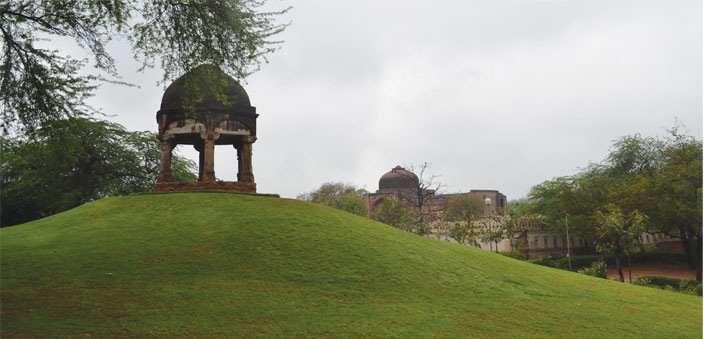
The Jamali Mosque is situated adjacent to the tomb in another walled enclosure. While larger congregational mosques were the feature of the earlier Delhi Sultans, they gave way to smaller single aisle mosques in the Lodi period – a style that was continued by the Mughals. Hence, the Jamali mosque is unique to have been built in the Lodi style with features that appear in mosques earlier yet considered the first example of Mughal architecture in India. Somewhere along the way in time, the two monuments started being called by the rhyming expression of Jamali-Kamali.
Approximately a century later, within the precincts of the MAP, at the very edge of what was Lal Kot, is built a tomb of Muhammad Quli Khan – the brother of Adham Khan; both of whom were sons of his wet nurse Maham Anga, and foster brothers of Mughal Emperor Akbar.
The British era
With Shah Jahan building his capital of Shahjahanabad much further north than the historic Delhi settlements, and then the prolonged campaign of Aurangzeb in the South, the attention moved away from Delhi for a while – until it came back, that is. During the time when the British were wanting to extend their toe-grip over the subcontinent, Sir Thomas Metcalfe was the last British Resident at the Mughal Court of Emperor Bahadur Shah Zafar II.
Sir Thomas Metcalfe purchased from the descendants of Quli Khan his tomb and had it renovated into a retreat which he also rented out to honeymooning couples. This retreat of landscaped terraces, gardens and guesthouses came to be known as Dilkusha (Delight of the Heart). In what seems like a strange choice of residence, Sir Thomas removed from the main tomb the cenotaph, and used the chamber as a dining room. Additionally, he added several rooms to the outside of the tomb chamber. Landscaping was done by introducing water channels. Other old buildings were converted into guest rooms, staff quarters and stables. Within the grounds, he also built follies. One of them is within the MAP, opposite the Jamali Kamali mosque.
Many more Delhis
While the seven cities of Delhi are widely spoken of, many authorities take smaller towns and strongholds into account and with that they claim that it changed site as much as 15 times. And this is just from what we know. Yet.
Imagine how many more Delhis could be lurking within…waiting to be discovered..to jut out from the layers of forgetfulness carrying with it another mystery….another Delhi. Former Prime Minister Jawaharlal Nehru spoke quite apt words in a description that is as true for the Mehrauli Archaeological Park as it is for Delhi –
“We face the good and the bad of India in Delhi city which has been the grave of many empires and the nursery of a republic. What a tremendous story of hers! Here the tradition of millennia of our history surrounds us at every step, and the procession of innumerable generations passes by before our eyes”

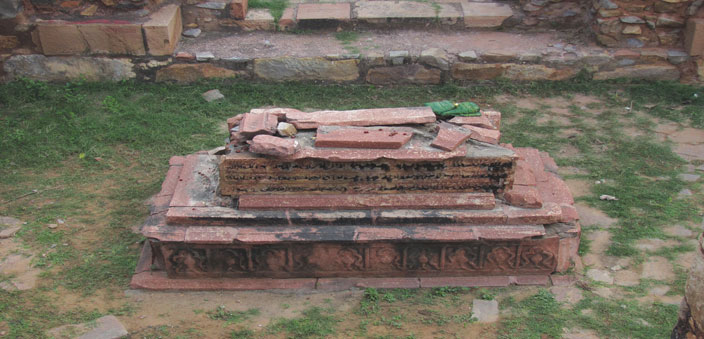
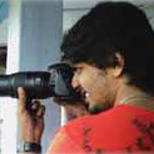 [/column]
[/column]